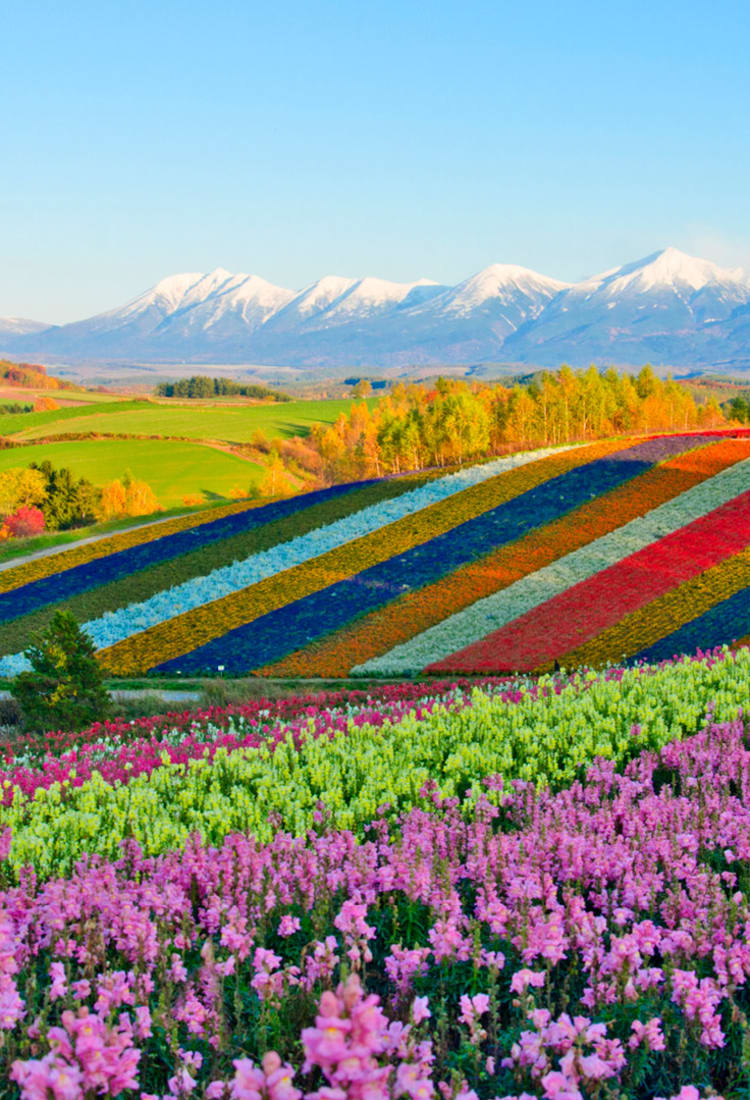
Hokkaido Incredible flavours gifted by nature
The Hokkaido “brand”
With a vast and fertile land that occupies one-fifth of Japan, a climate with cold winters and cool summers, and the surrounding sea, Hokkaido produces a unique variety of ingredients by taking advantage of its rich nature. Hokkaido’s ingredients are well-recognized in the market, making the Hokkaido name almost a brand unto itself.
Hokkaido ranks first in the domestic production of wheat, soybeans, adzuki beans, kidney beans, potatoes, onions, asparagus, raw milk, scallops, pollock, atka mackerel, salmon, saury, and kelp. The region's cold winters and cool summers make it a major producer of agricultural products, which are also suitable for storage. Additionally, Hokkaido is known to use fewer pesticides and chemical fertilizers compared to other prefectures.
Hokkaido is larger than New Brunswick, so even a single dish can have different characteristics depending on the area. For example, when it comes to ramen, you can enjoy a wide variety of flavours such as Sapporo ramen, Asahikawa ramen, Hakodate ramen, Kushiro ramen, and Muroran ramen.
Let's take a closer look at some of the popular local foods that highlight Hokkaido's culinary excellence.
Uni-don (Sea urchin bowl)

What it is (ingredients)
Uni-don primarily consists of fresh sea urchin (Uni) served over a bowl of steamed rice. The sea urchin is often complemented by nori (seaweed), wasabi, and soy sauce. Some variations may include additional toppings like Ikura (salmon roe) or shiso leaves to enhance the flavour.
History/Origin
Uni-don has a rich history tied to the coastal regions of Hokkaido, where sea urchin fishing has been a traditional practice for centuries. The dish gained popularity due to the unique, creamy texture and delicate flavour of Hokkaido's sea urchin. Local fishermen historically consumed Uni fresh from the sea, which evolved into the refined dish enjoyed today.
Where You Can Eat
In Hokkaido, you can find Uni-don at many seafood markets, specialty restaurants, and sushi bars. Local eateries near fishing ports particularly excel in serving fresh Uni-don. The Shakotan Peninsula, a 2-hour drive from Sapporo, and Rishiri Island, situated close to Japan's northernmost point, are renowned for their sea urchin production, each offering distinct varieties of this delicacy.
When to Eat
The best season to enjoy Uni-don in Hokkaido is from late June to August, when sea urchins are at their peak in terms of flavour and texture. During this time, the uni is harvested from the cold, clean waters of Hokkaido, ensuring the freshest and most delectable experience.
Indulge in the exquisite taste of Uni-don and experience a culinary tradition that captures the essence of Hokkaido's bountiful seas.
Jingisukan (Grilled Lamb)

What it is (ingredients)
Jingisukan is prepared by grilling thinly sliced lamb meat, typically marinated in a savoury soy-based sauce enriched with garlic and other spices, on a curved metal skillet. This method not only gathers the meat juices but also intensifies its flavour.
History/Origin
The exact origins of Jingisukan are unclear, but it is believed that it was inspired by China and made to suit the Japanese palate. The dish gained popularity around the mid-20th century, coinciding with the rise of lamb farming in Hokkaido's cool climate. Today, Jingisukan is celebrated as a quintessential local delicacy that embodies Hokkaido's distinctive culinary heritage.
Where You Can Eat
Hokkaido's renowned dish, named after the Mongolian leader Genghis Khan, is a specialty available at dedicated restaurants throughout Hokkaido, particularly in Sapporo, other major cities, and areas known for sheep farming.
When to Eat
Jingisukan is enjoyed year-round in Hokkaido, but it is particularly popular during colder months when the hearty, grilled lamb provides warmth and comfort. The dish pairs well with local beers and sake, making it a favorite choice for gatherings and celebrations, especially in autumn and winter.
Savour the robust flavours of Jingisukan and immerse yourself in Hokkaido's culinary heritage with this delicious lamb barbecue tradition.
Zangi (Hokkaido-Style Deep-fried Chicken)

What it is (ingredients)
Zangi is a popular fried chicken dish from Hokkaido, characterized by its flavourful marinade and crispy texture. The key ingredients include chicken pieces, typically thighs or wings, marinated in a mixture of soy sauce, garlic, ginger and other seasonings. The marinated chicken is then coated in a light batter or flour and deep-fried to perfection, resulting in a juicy interior and a crunchy exterior.
History/Origin
Zangi has a short history and is said to have been created by a chicken restaurant in Kushiro City in the mid-20th century. The origin of the name is the owner added an “n'' between the letters in order to bring good luck to the Chinese fried chicken “zha ji,'' and the name became “Zangi.” Nowadays, in addition to chicken, fried dishes of octopus and salmon are also being called “Zangi.'' Regardless of its exact origins, Zangi has firmly established itself as Hokkaido's beloved soul food, praised for its satisfying crunch and flavour. Over the years, this humble dish has become a staple in local cuisine, available at festivals, gatherings, and everyday meals.
Where to eat
Zangi, a beloved Hokkaido specialty, can be found in various eateries across the region, ranging from cozy Izakaya (Japanese-style dining bar) to supermarkets and convenience stores. Many local Izakaya and traditional Japanese pubs feature Zangi as a popular menu item, providing an authentic dining experience for both locals and tourists alike.
When to eat
Zangi is enjoyed year-round in Hokkaido. Whether as a quick snack or part of a larger meal, Zangi is a delightful treat any time of the year.
Zangi acts as a culinary ambassador for Hokkaido, inviting visitors to savour the flavours of this enchanting region. Whether enjoyed in a cozy restaurant or prepared at home, this beloved dish encapsulates the essence of Hokkaido's rich culinary heritage, offering a tantalizing glimpse into the diverse and delicious world of local Hokkaido cuisine.































































